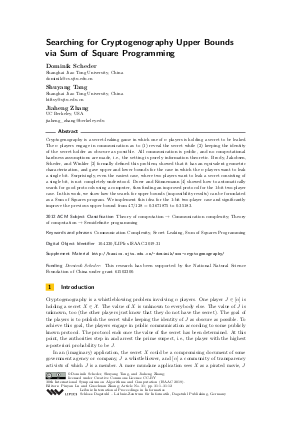Searching for Cryptogenography Upper Bounds via Sum of Square Programming
Authors Dominik Scheder, Shuyang Tang, Jiaheng Zhang
-
Part of:
Volume:
30th International Symposium on Algorithms and Computation (ISAAC 2019)
Part of: Series: Leibniz International Proceedings in Informatics (LIPIcs)
Part of: Conference: International Symposium on Algorithms and Computation (ISAAC) - License:
 Creative Commons Attribution 3.0 Unported license
Creative Commons Attribution 3.0 Unported license
- Publication Date: 2019-11-28
File

PDF
LIPIcs.ISAAC.2019.31.pdf
- Filesize: 0.54 MB
- 12 pages
Document Identifiers
Subject Classification
ACM Subject Classification
- Theory of computation → Communication complexity
- Theory of computation → Semidefinite programming
Keywords
- Communication Complexity
- Secret Leaking
- Sum of Squares Programming
Metrics
- Access Statistics
-
Total Accesses (updated on a weekly basis)
0Document
0Metadata
Abstract
Cryptogenography is a secret-leaking game in which one of n players is holding a secret to be leaked. The n players engage in communication as to (1) reveal the secret while (2) keeping the identity of the secret holder as obscure as possible. All communication is public, and no computational hardness assumptions are made, i.e., the setting is purely information theoretic. Brody, Jakobsen, Scheder, and Winkler [Joshua Brody et al., 2014] formally defined this problem, showed that it has an equivalent geometric characterization, and gave upper and lower bounds for the case in which the n players want to leak a single bit. Surprisingly, even the easiest case, where two players want to leak a secret consisting of a single bit, is not completely understood. Doerr and Künnemann [Benjamin Doerr and Marvin Künnemann, 2016] showed how to automatically search for good protocols using a computer, thus finding an improved protocol for the 1-bit two-player case. In this work, we show how the search for upper bounds (impossibility results) can be formulated as a Sum of Squares program. We implement this idea for the 1-bit two-player case and significantly improve the previous upper bound from 47/128 = 0.3671875 to 0.35183.
Cite As Get BibTex
Dominik Scheder, Shuyang Tang, and Jiaheng Zhang. Searching for Cryptogenography Upper Bounds via Sum of Square Programming. In 30th International Symposium on Algorithms and Computation (ISAAC 2019). Leibniz International Proceedings in Informatics (LIPIcs), Volume 149, pp. 31:1-31:12, Schloss Dagstuhl – Leibniz-Zentrum für Informatik (2019)
https://doi.org/10.4230/LIPIcs.ISAAC.2019.31
BibTex
@InProceedings{scheder_et_al:LIPIcs.ISAAC.2019.31,
author = {Scheder, Dominik and Tang, Shuyang and Zhang, Jiaheng},
title = {{Searching for Cryptogenography Upper Bounds via Sum of Square Programming}},
booktitle = {30th International Symposium on Algorithms and Computation (ISAAC 2019)},
pages = {31:1--31:12},
series = {Leibniz International Proceedings in Informatics (LIPIcs)},
ISBN = {978-3-95977-130-6},
ISSN = {1868-8969},
year = {2019},
volume = {149},
editor = {Lu, Pinyan and Zhang, Guochuan},
publisher = {Schloss Dagstuhl -- Leibniz-Zentrum f{\"u}r Informatik},
address = {Dagstuhl, Germany},
URL = {https://drops.dagstuhl.de/entities/document/10.4230/LIPIcs.ISAAC.2019.31},
URN = {urn:nbn:de:0030-drops-115276},
doi = {10.4230/LIPIcs.ISAAC.2019.31},
annote = {Keywords: Communication Complexity, Secret Leaking, Sum of Squares Programming}
}
Author Details
Funding
- Scheder, Dominik: This research has been supported by the National Natural Science Foundation of China under grant 61502300.
Supplementary Materials
References
- Mark Braverman, Ankit Garg, Denis Pankratov, and Omri Weinstein. From information to exact communication. In Dan Boneh, Tim Roughgarden, and Joan Feigenbaum, editors, Symposium on Theory of Computing Conference, STOC'13, Palo Alto, CA, USA, June 1-4, 2013, pages 151-160. ACM, 2013. URL: https://doi.org/10.1145/2488608.2488628.
- Joshua Brody, Sune K. Jakobsen, Dominik Scheder, and Peter Winkler. Cryptogenography. In Moni Naor, editor, Innovations in Theoretical Computer Science, ITCS'14, Princeton, NJ, USA, January 12-14, 2014, pages 13-22. ACM, 2014. URL: https://doi.org/10.1145/2554797.2554800.
-
Thomas M. Cover and Joy A. Thomas. Elements of Information Theory (Wiley Series in Telecommunications and Signal Processing). Wiley-Interscience, New York, NY, USA, 2006.

- Benjamin Doerr and Marvin Künnemann. Improved Protocols and Hardness Results for the Two-Player Cryptogenography Problem. In Ioannis Chatzigiannakis, Michael Mitzenmacher, Yuval Rabani, and Davide Sangiorgi, editors, 43rd International Colloquium on Automata, Languages, and Programming, ICALP 2016, July 11-15, 2016, Rome, Italy, volume 55 of LIPIcs, pages 150:1-150:13. Schloss Dagstuhl - Leibniz-Zentrum fuer Informatik, 2016. URL: https://doi.org/10.4230/LIPIcs.ICALP.2016.150.
- Sune K. Jakobsen. Information Theoretical Cryptogenography. J. Cryptology, 30(4):1067-1115, 2017. URL: https://doi.org/10.1007/s00145-016-9242-8.
- Sune K. Jakobsen and Claudio Orlandi. How To Bootstrap Anonymous Communication. In Proceedings of the 2016 ACM Conference on Innovations in Theoretical Computer Science, ITCS '16, pages 333-344, New York, NY, USA, 2016. ACM. URL: https://doi.org/10.1145/2840728.2840743.
- Jean B. Lasserre. A Sum of Squares Approximation of Nonnegative Polynomials. SIAM J. on Optimization, 16(3):751-765, March 2006. URL: https://doi.org/10.1137/04061413X.
- Monique Laurent. Sums of Squares, Moment Matrices and Optimization Over Polynomials. In Mihai Putinar and Seth Sullivant, editors, Emerging Applications of Algebraic Geometry, pages 157-270. Springer New York, New York, NY, 2009. URL: https://doi.org/10.1007/978-0-387-09686-5_7.
-
J. Löfberg. YALMIP : A Toolbox for Modeling and Optimization in MATLAB. In In Proceedings of the CACSD Conference, Taipei, Taiwan, 2004.

- A. Papachristodoulou, J. Anderson, G. Valmorbida, S. Prajna, P. Seiler, and P. A. Parrilo. SOSTOOLS: Sum of squares optimization toolbox for MATLAB, 2013. Available from http://www.eng.ox.ac.uk/control/sostools, http://www.cds.caltech.edu/sostools and http://www.mit.edu/~parrilo/sostools. URL: http://arxiv.org/abs/1310.4716.
- Antonis Papachristodoulou, James Anderson, Giorgio Valmorbida, Stephen Prajna, Pete Seiler, and Pablo A. Parrilo. SOSTOOLS version 3.00 sum of squares optimization toolbox for MATLAB. CoRR, abs/1310.4716, 2013. URL: http://arxiv.org/abs/1310.4716.
